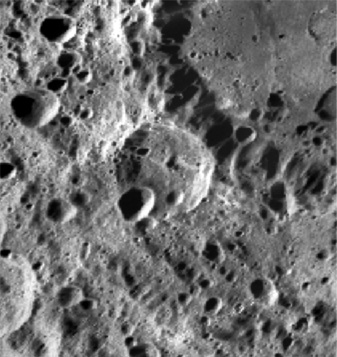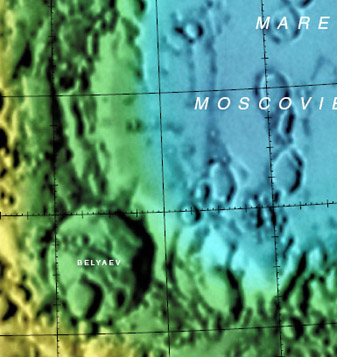Difference between revisions of "Belyaev"
| (One intermediate revision by the same user not shown) | |||
| Line 5: | Line 5: | ||
|- | |- | ||
| | | | ||
| − | [http://www.lpod.org/coppermine/displayimage.php?pid=4134&fullsize=1 [[Image: | + | [http://www.lpod.org/coppermine/displayimage.php?pid=4134&fullsize=1 [[Image:Belyaev.jpg|belyaev.jpg]]]<br /> |
| | | | ||
| − | [[Image: | + | [[Image:Belyaev-color.jpg|belyaev-color.jpg]]<br /> |
|} | |} | ||
(Left) [http://webgis.wr.usgs.gov/website/lunorb_html/viewer.htm Lunar Orbiter Viewer] from [http://webgis.wr.usgs.gov/pigwad/maps/the_moon.htm USGS On-line Moon Maps]. (Right) [http://planetarynames.wr.usgs.gov/images/Lunar/lac_48.pdf Color-coded LAC 48] from [[USGS%20Digital%20Atlas|USGS Digital Atlas]] (grid spacing = 2 degrees).<br /> <div id="toc"> | (Left) [http://webgis.wr.usgs.gov/website/lunorb_html/viewer.htm Lunar Orbiter Viewer] from [http://webgis.wr.usgs.gov/pigwad/maps/the_moon.htm USGS On-line Moon Maps]. (Right) [http://planetarynames.wr.usgs.gov/images/Lunar/lac_48.pdf Color-coded LAC 48] from [[USGS%20Digital%20Atlas|USGS Digital Atlas]] (grid spacing = 2 degrees).<br /> <div id="toc"> | ||
| Line 18: | Line 18: | ||
''([[LAC%20zone|LAC zone]] 48C1)'' [http://planetarynames.wr.usgs.gov/images/Lunar/lac_48.pdf USGS Digital Atlas PDF]<br /> <br /> | ''([[LAC%20zone|LAC zone]] 48C1)'' [http://planetarynames.wr.usgs.gov/images/Lunar/lac_48.pdf USGS Digital Atlas PDF]<br /> <br /> | ||
==Description== | ==Description== | ||
| − | <span style="font-family: Arial">'''Belyaev's''' worn-down appearance suggests an old crater. Situated between two rims of the [[Mare%20Moscoviense|Moscoviense Basin]] -- whose main rim is 445 km wide and of the [[stratigraphy|Nectarian]] period (3.92 - 3.85 bn years), the crater lies on ejecta deposits from that basin and so obviously is younger. Several small craters ranging from 2 to 5 kilometres lie on the rim of '''Belyaev''', while a much larger one about 20 km across has totally wiped out its south-west portion. The floor looks relatively flat, interupted only by a series of hills that predominantly run in a NW-SE direction. <span class="membersnap">- | + | <span style="font-family: Arial">'''Belyaev's''' worn-down appearance suggests an old crater. Situated between two rims of the [[Mare%20Moscoviense|Moscoviense Basin]] -- whose main rim is 445 km wide and of the [[stratigraphy|Nectarian]] period (3.92 - 3.85 bn years), the crater lies on ejecta deposits from that basin and so obviously is younger. Several small craters ranging from 2 to 5 kilometres lie on the rim of '''Belyaev''', while a much larger one about 20 km across has totally wiped out its south-west portion. The floor looks relatively flat, interupted only by a series of hills that predominantly run in a NW-SE direction. <span class="membersnap">- JohnMoore2</span></span><br /> <br /> |
==Description: Wikipedia== | ==Description: Wikipedia== | ||
[http://en.wikipedia.org/wiki/Belyaev_(crater) Belyaev]<br /> <br /> | [http://en.wikipedia.org/wiki/Belyaev_(crater) Belyaev]<br /> <br /> | ||
Latest revision as of 20:01, 16 April 2018
Contents
Belyaev
| Lat: 23.3°N, Long: 143.5°E, Diam: 54 km, Depth: km, Rükl: (farside) | |
Images
LPOD Photo Gallery Lunar Orbiter Images Apollo Images (see also Mare Moscoviense)
- Note: Belyaev can be found in LAC 48 of the USGS Digital Atlas of the Moon, however, as this LAC is currently under construction (as of 7 June 2009 at time of writing), updates should be checked for.
Maps
(LAC zone 48C1) USGS Digital Atlas PDF
Description
Belyaev's worn-down appearance suggests an old crater. Situated between two rims of the Moscoviense Basin -- whose main rim is 445 km wide and of the Nectarian period (3.92 - 3.85 bn years), the crater lies on ejecta deposits from that basin and so obviously is younger. Several small craters ranging from 2 to 5 kilometres lie on the rim of Belyaev, while a much larger one about 20 km across has totally wiped out its south-west portion. The floor looks relatively flat, interupted only by a series of hills that predominantly run in a NW-SE direction. - JohnMoore2
Description: Wikipedia
Additional Information
Central peak composition: Anorthosite & GNTA1 (Tompkins & Pieters, 1999)
Nomenclature
Pavel Ivanovich; Soviet cosmonaut (1925-1970).
LPOD Articles
Bibliography

